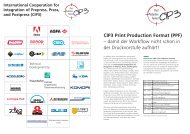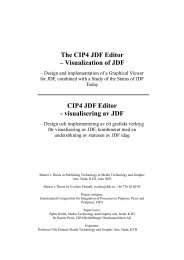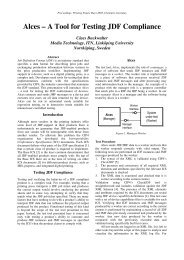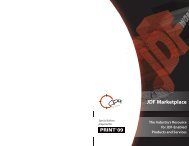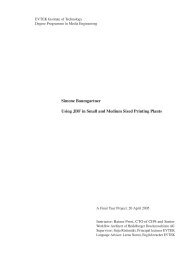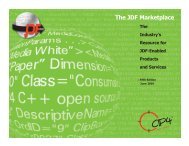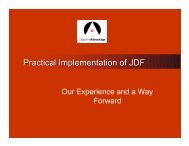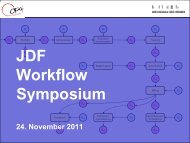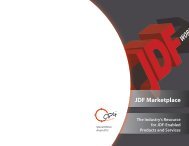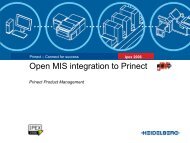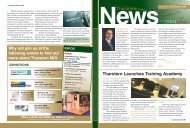Print Automation Case Study: Modern Litho-Print Co. 6009 ... - CIP4
Print Automation Case Study: Modern Litho-Print Co. 6009 ... - CIP4
Print Automation Case Study: Modern Litho-Print Co. 6009 ... - CIP4
Create successful ePaper yourself
Turn your PDF publications into a flip-book with our unique Google optimized e-Paper software.
<strong>Print</strong> <strong>Automation</strong> <strong>Case</strong> <strong>Study</strong>:<br />
<strong>Modern</strong> <strong>Litho</strong>-<strong>Print</strong> <strong>Co</strong>.<br />
<strong>6009</strong> Stertzer Road<br />
Jefferson City, MO 65101<br />
www.<strong>Modern</strong><strong>Litho</strong>.com<br />
Date: August 13, 2010<br />
2010 <strong>Print</strong> <strong>Automation</strong> <strong>Case</strong> <strong>Study</strong><br />
<strong>Modern</strong> <strong>Litho</strong>-<strong>Print</strong> Page 1 of 19
2010 <strong>Print</strong> <strong>Automation</strong> <strong>Case</strong> <strong>Study</strong><br />
Executive Summary<br />
<strong>Modern</strong> <strong>Litho</strong>-<strong>Print</strong> <strong>Co</strong>., a certified woman-owned business located in Jefferson City, Missouri,<br />
has been in business for 73 years.<br />
<strong>Modern</strong> <strong>Litho</strong>, along with its sister<br />
company, Brown <strong>Print</strong>ing, Inc., are<br />
wholly-owned subsidiaries of <strong>Co</strong>venant<br />
Graphics, Inc. (CGI), a holding<br />
company. CGI had 2009 revenues of<br />
$14.7 million. The company, whose<br />
President is Darrell Moore, has<br />
about 118 employees, including 14<br />
sales professionals located around<br />
the country. <strong>Modern</strong> <strong>Litho</strong> specializes<br />
in the manufacture of publications<br />
and association-related<br />
printing. July 2010 marks the company’s<br />
one-year anniversary of utilizing<br />
a digital job ticket.<br />
<strong>Modern</strong> <strong>Litho</strong> is the only company in North America that is running the entire EFI Monarch MIS<br />
Suite, integrated with Kodak Prinergy/InSite. This configuration has enabled the company to implement<br />
a level of automation as close to “lights out” as a publication printer could possibly be,<br />
and resulted in room to grow the company by 25% without adding additional people or technology<br />
resources. The following hardware and software are integrated into this seamless digital<br />
workflow:<br />
� EFI <strong>Print</strong>erSite Internal, V 10.0.0.0<br />
� EFI Monarch Foundation (formerly Hagen<br />
OA), V 2010.1.1.1<br />
� EFI Monarch Planner, V 2010.1.2.94<br />
� Kodak InSite Prepress Portal,<br />
V 6.1.0.7475<br />
� Kodak InSite Storefront, V 3.1.2.2776<br />
� Kodak Prinergy, V 5.1.2.2<br />
� Kodak Rules Based <strong>Automation</strong><br />
� Kodak Virtual Matchprint, V 6.0.1<br />
� EFI <strong>Print</strong>Flow, V 2010.1.23.4<br />
� EFI Auto-<strong>Co</strong>unt, V 2010.1.3.2<br />
� EFI Plant Manager, V 2010.1.3.2<br />
� Microsoft Excel 2007<br />
� SmartLinc Smartware09, V 1.0.0.0<br />
� CCH Sales Tax Service<br />
� Heidelberg Prinect Prepress Interface<br />
V 3.3<br />
� Kodak Magnus Platesetter<br />
� XL 105 Heidelberg 5 color with Aqueous and<br />
roll to sheet capabilities<br />
� Heidelberg 102 - 6 color<br />
� 2 Heidelberg 102 - 4 color<br />
� Heidelberg SM 52 - 5 color<br />
� Heidelberg 450 Stitcher – 6 pocket with two<br />
cover feeders<br />
� Mueller Martini Bravo T Stitcher – 8 pocket<br />
with <strong>Co</strong>ver feeder<br />
� Mueller Martini Acoro Perfect Binder with<br />
PUR glue option – 20 pocket<br />
� Heidelberg Stahl Folder RFH 82<br />
� MBO B26 Buckle Folder<br />
� MBO R 820 Knife Folder<br />
� MBO B26 Folder<br />
� <strong>Co</strong>rdoba Score/Perf Machine<br />
� Buhrs 3000 Polybagger<br />
� 2 VideoJet Ink Jet Systems with 2 Cheshire<br />
Tabbing units<br />
Two years ago, <strong>Modern</strong> <strong>Litho</strong> was running its business on a paper job ticket. Requests for estimates<br />
received via Sales or direct from the customer were often incomplete, requiring multiple<br />
contacts to gain sufficient information in order to generate an estimate, resulting in two or three<br />
days on average before a quote could be provided to the customer. Since many customers act on<br />
the first quote(s) they receive, this lead time likely cost the company business, although at the<br />
<strong>Modern</strong> <strong>Litho</strong>-<strong>Print</strong> Page 2 of 19
2010 <strong>Print</strong> <strong>Automation</strong> <strong>Case</strong> <strong>Study</strong><br />
time, systems were not in place to accurately track win/loss rates and reasons for losing. Alternatively,<br />
a quote would be generated based on incomplete information, including page counts which<br />
often cannot be finalized until the file is submitted and processed. Although the estimate, and the<br />
order when received, were entered into Hagen, there was still a paper job ticket wending its way<br />
through the plant and many conversations taking place among sales, CSRs and production to<br />
shepherd the job through the plant. Perhaps the most glaring example of the inefficiency in the<br />
previous process is the fact that the then-Plant Superintendent was spending two to four hours per<br />
day manually writing the production schedule for five presses, and the Bindery Foreman spent<br />
one to two hours per day creating a written bindery schedule for the third shift.<br />
With the new automated process in place, the entire workflow is much more streamlined. <strong>Print</strong>er-<br />
Site Internal, using custom order forms, will not allow Sales to submit a request for estimate<br />
unless all required information is present. Estimates are turned around in no more than two days,<br />
and many times, same day, based on customer requirements. Once the quote is accepted by the<br />
customer and files are uploaded, processing files, creating the job ticket, proofing, imposition,<br />
planning and scheduling are all compressed into a series of parallel actions, many of which are<br />
automated. Proofs are delivered within 10 minutes of file upload, and the entire color calibrated<br />
remote monitor proofing process can be concluded within hours rather than four to five days<br />
minimum with hardcopy proofs in the past. This means the job can be ready to go to press within<br />
a few hours of the quote being accepted. In the vast majority of cases, press checks are no longer<br />
required.<br />
This has caused a domino effect throughout the entire plant, making jobs run through smoothly<br />
from that point, almost always without a hitch. <strong>Modern</strong> <strong>Litho</strong> has experienced a minimum of two<br />
days reduction in turnaround time and some automated jobs are running through the plant in one<br />
to two days without problems. Nearly 2,500 hours annually are being saved in the press room,<br />
165 hours saved on invoicing, and more accurate invoices are now being delivered three to five<br />
days faster. Press re-runs and bindery shortages are virtually a thing of the past.<br />
From a business perspective, <strong>Modern</strong> <strong>Litho</strong> now has all business and production information<br />
available in real time for better business management and capacity to grow 25% without adding<br />
more resources.<br />
This has been a revolutionary transformation for <strong>Modern</strong> <strong>Litho</strong> in a very short timeframe. The<br />
company marks the starting point at the implementation of the electronic job ticket in July of<br />
2009, with the final pieces of the puzzle being put in place during August of 2010. Not only is<br />
the business on a more solid and productive footing from the perspective of internal operations,<br />
but it is much better positioned to serve customers, both acquiring new customers and retaining<br />
existing ones. While there are no definitive customer satisfaction metrics in place, there are virtually<br />
no more customer complaints being received, which speaks volumes for the response from<br />
customers to this new automated process.<br />
Section I. Background — Before its new highly automated JDF-based workflow was put in<br />
place, <strong>Modern</strong> <strong>Litho</strong> was like many other printing companies. Everything was based on a paper<br />
job ticket that followed the job through the plant. And the many manual steps in the production<br />
process meant that job tickets, jobs and people were constantly moving backwards in the process<br />
to correct errors, collect missing information and more. The diagram below reflects the workflow<br />
as it existed in the past. A full description follows.<br />
<strong>Modern</strong> <strong>Litho</strong>-<strong>Print</strong> Page 3 of 19
2010 <strong>Print</strong> <strong>Automation</strong> <strong>Case</strong> <strong>Study</strong><br />
Estimates and Quotes<br />
This manual process began with a sales rep completing a handwritten preorder sheet based on<br />
what he was able to learn from the customer about the proposed job. This information is often<br />
incomplete or incorrect. This means that once the estimator begins working the estimate, she<br />
must call the customer or the sales rep to obtain the required information, causing delays. In addition,<br />
handwritten preorder sheets can be difficult to read and result in miscommunications on<br />
job specifications. Average turnaround time for an estimate, historically, was 2-3 days. Customers<br />
were beginning to complain, and it is not clear how many jobs we lost due to delays in delivering<br />
estimates.<br />
Once the estimate is complete, the sales rep discusses the quote with the customer, notifying the<br />
CSR when the customer accepts the quote.<br />
Creating a Job in the System<br />
Once the quote is accepted, the CSR enters information into Hagen (now Monarch) based on<br />
available information. Quotes sometimes must be reissued as more data becomes available. The<br />
CSR creates a handwritten job ticket (See Appendix B for image). This job ticket’s first stop is<br />
Desktop, awaiting customer files.<br />
<strong>Modern</strong> <strong>Litho</strong>-<strong>Print</strong> Page 4 of 19
2010 <strong>Print</strong> <strong>Automation</strong> <strong>Case</strong> <strong>Study</strong><br />
File Handling<br />
When customer files are ready, the customer uploads them into Kodak InSite, triggering notification<br />
to Desktop that files are ready to be processed. Desktop must examine files and work with<br />
the CSR on differences between the files and the quote; this most often involves discrepancies in<br />
page counts. At this stage, the handwritten job ticket is often revised, and sometimes quotes need<br />
to be reissued to reflect the actual job specifications. Desktop creates the job in Prinergy, dropping<br />
in prepared files and sends the paper job ticket to Prepress.<br />
Prepress uses Preps in Prinergy to create impositions and adjust files as necessary. Paper requirements<br />
are calculated manually, and paper is either manually ordered or reserved in in-house<br />
stock. Forms and runs for presses, including impositions, are listed on the back of the job ticket.<br />
Proofing<br />
Prepress creates proofs in hardcopy or posts to InSite, depending on customer requirements.<br />
Hardcopy proofs are overnighted to the customer, causing a day delay and the costs associated<br />
with shipping. The customer reviews the proof, sometimes with multiple iterations. From generation<br />
to approval, the proofing process can take 4 to 5 days or more, and again incurs the time and<br />
cost of overnight shipping the proof back.<br />
Prepress makes changes requested by customer in Prinergy, manually removing old pages and inserting<br />
new ones. This can be an error-prone process. If more than 50% of the pages are<br />
changed, another proof goes back to the customer, repeating the cycle. Sometimes AA’s are not<br />
captured for invoicing purposes.<br />
Plating<br />
When proofs are approved by the customer, Prepress sends the job to the Trendsetter for plating,<br />
manually loading and unloading plates. The Prepress operator places plates in a rack with handwritten<br />
labels reflecting the job number and other relevant information. The job ticket then goes<br />
to the Plant Superintendent for scheduling.<br />
Scheduling<br />
The Plant Superintendent builds a daily press list by hand<br />
(see example in Appendix C) for all five presses. This<br />
process was started by his predecessor and became<br />
increasingly onerous, taking two to four hours per day of<br />
his time. A copy of the press list is provided to each press<br />
operator along with paper job tickets, and to the warehouse<br />
for paper staging. On weekends, it can be difficult for press<br />
operators to know what is ready to run.<br />
The bindery manager also handwrites a daily schedule for<br />
bindery, consuming one to two hours of his time.<br />
Production<br />
With the schedule and job ticket in hand, the press operator<br />
retrieves the plates from the rack, comparing the job number on the job ticket and<br />
the plates, inspects the plates and loads on press. The press operator initially sets<br />
ink keys by hand and eye, starting the run on best guess, and continues to waste<br />
paper until color quality is met. It is a manual process to determine and track<br />
makeready waste.<br />
<strong>Modern</strong> <strong>Litho</strong>-<strong>Print</strong> Page 5 of 19
2010 <strong>Print</strong> <strong>Automation</strong> <strong>Case</strong> <strong>Study</strong><br />
Load tags are manually written for each form as it comes off of the press, including job number,<br />
count (which may or may not be accurate), and form number. These are placed on the skid for<br />
each form. The job ticket moves to Bindery upon completion of the press run.<br />
Bindery<br />
Bindery looks at the handwritten schedule and searches for the job ticket to sort out the number of<br />
forms listed on the back. Reads load tickets to match up to job ticket. Shortages may require reruns<br />
in quantities as low as 200 sheets if counts are off. Job ticket moves to shipping/mailing.<br />
Distribution<br />
Bound product is transferred to mailing, or shipping by UPS or a freight line. Shipping manually<br />
fills out the UPS form online, writes the tracking number on the job ticket. Job ticket is sent to<br />
accounting.<br />
Invoicing<br />
Accounting checks all steps to make sure everything is invoiced, including extra proofs, AAs and<br />
shipping. If UPS tracking number is not available or cannot be read, this requires additional research.<br />
Sales tax is calculated manually.<br />
Financial Performance<br />
Inadequate systems are in place to easily track actual versus estimate, job or customer profitability<br />
and other financial metrics required to run the business.<br />
Section II. Objectives — The company had made significant capital investments in presses,<br />
bindery and mailing equipment, in excess of $12 million in the last ten years. Management’s emphasis<br />
for 2009 was to improve and streamline processes and procedures to take full advantage of<br />
those investments.<br />
With the impending retirement of the Plant Superintendent, the Assistant Plant Superintendent<br />
(now Director of Operations) knew that there had to be a better way to manage the business. He<br />
was not anxious to spend two to four hours per day manually scheduling, and believed that the<br />
technology was available to dramatically change the company’s workflow for the better. In the<br />
summer of 2008, he attended EFI <strong>Co</strong>nnect, EFI’s user group, to explore what could be done,<br />
building on the company’s existing Hagen MIS system and Kodak’s Prinergy and InSite. He was<br />
delighted with what he learned at <strong>Co</strong>nnect, including the ability to speak with representatives of<br />
both EFI and Kodak at the same event, and began to put the transformation process into play. At<br />
the time, it was sufficient to understand the opportunity for improving workflow through process<br />
automation. The company had no real basis for projecting the outcome based on lack of data and<br />
the manual nature of the existing workflow. Nonetheless, there was a vision and a commitment<br />
to improving productivity and workflow, and a belief that the business would benefit from these<br />
investments. This leap of faith generated results far beyond expectations.<br />
Section III. Methodology — The core solutions for <strong>Modern</strong> <strong>Litho</strong>’s workflow automation initiative<br />
were already in place prior to beginning this project, but were not connected. Those were<br />
EFI’s Hagen OA (now Monarch Foundation) and Kodak’s Prinergy and InSite. In our discussions<br />
with these two suppliers, we believed we could not only get the support and cooperation we<br />
needed to integrate this multivendor workflow, but that both companies had the requisite capabilities<br />
to make it happen. As a result of that decision, and all of the hard work by all parties, we believe<br />
<strong>Modern</strong> <strong>Litho</strong> is the first company in the United States that is running the entire Monarch<br />
Suite integrated with Prinergy/InSite and benefiting from bi-directional JDF/JMF connectivity.<br />
This is the workflow “Holy Grail” that everyone has been pursuing since JDF was first brought to<br />
<strong>Modern</strong> <strong>Litho</strong>-<strong>Print</strong> Page 6 of 19
2010 <strong>Print</strong> <strong>Automation</strong> <strong>Case</strong> <strong>Study</strong><br />
the market and its promise was understood. EFI’s integration with SmartLinc for automation of<br />
shipping documents is also in place. Integration between Monarch Foundation/Planner and Xpedx<br />
for automated ordering of paper is in the development process with EFI and Xpedx. Both are<br />
critical elements of this story.<br />
Once we had commitments from our existing vendor partners and understood the full range of<br />
available capabilities, we did not feel the need to pursue other solutions. The results we have<br />
achieved validated our decision process.<br />
Section IV. Implementation Story — This implementation was quite rapid and involved virtually<br />
everyone in the plant, as well as assistance from EFI, Kodak and Heidelberg. It was a true<br />
team effort. Although as one might expect, there were challenges along the way, they were easily<br />
overcome through this team effort. The timeline below reflects the amazingly brief amount of<br />
elapsed time from start to finish. Key milestones are reflected on this timeline.<br />
The first three to six months of implementation involved a complete review of every work center<br />
and operation for every machine in production. We analyzed speeds, waste and paper inventory<br />
before entering that data into the Hagen system. Many hours of setup were required to make sure<br />
the model fit reality; i.e., was the time and paper waste for each production process realistic. We<br />
also worked through many bugs and fixes with EFI support on a daily and weekly basis to assure<br />
bi-directional communication was working and each task was accounted for.<br />
<strong>Print</strong>Flow Scheduling also was set up and tested, with every machine appearing on <strong>Print</strong>Flow’s<br />
Gantt chart with jobs scheduling from Planning and sending data into Hagen.<br />
Upon completion of testing, we moved into a live environment which also uncovered more issues<br />
with connectivity and workflow that needed to be tweaked for the following month. With the<br />
completion of the work on the Planning and Scheduling modules, we then proceeded to enter into<br />
a beta with Kodak and EFI to bring Planner and Prinergy connectivity to the workflow. This required<br />
several weeks of setup and hundreds of hours of testing and feedback to both EFI and Kodak<br />
to integrate the most robust Prinergy prepress system into the first truly complete Planning<br />
<strong>Modern</strong> <strong>Litho</strong>-<strong>Print</strong> Page 7 of 19
2010 <strong>Print</strong> <strong>Automation</strong> <strong>Case</strong> <strong>Study</strong><br />
module. Monarch Suite was rolled out and EFI sent three support people into our facility to ensure<br />
a smooth upgrade, with our live environment being the first company to have Monarch Suite<br />
running with the prepress interface.<br />
One year into our implementation, we purchased Auto-<strong>Co</strong>unt for all presses. Networking cable<br />
(Cat5e) had to be run since connectivity would be necessary for the workflow, and work began<br />
with EFI support to connect each press to the workflow to be monitored. As a result, each machine<br />
had a new workstation with Auto-<strong>Co</strong>unt running, and that meant adding an additional step<br />
in the automated workflow.<br />
Once work got underway on the electronic job ticket, hours of planning/testing were required, as<br />
many pieces had to be tied into the ticket for live updates. Three months later, we purchased<br />
Auto-<strong>Co</strong>unt for the entire bindery as we recognized the huge impact it was making in the pressroom,<br />
and to complete the bi-directional workflow we finished networking as well.<br />
Then purchase/installation/setup began on <strong>Print</strong>erSite Internal. Three to four weeks of training<br />
and set up concluded with pre-defined templates for sales and that allowed us to begin training<br />
the sales team. We initially rolled <strong>Print</strong>erSite Internal out to three of our 14 sales people so they<br />
could start using it and supply feedback to allow us to perfect the system. Three months later,<br />
three more sales professionals were added and many more training sessions completed as we felt<br />
that the <strong>Print</strong>erSite Internal implementation cycle was complete and ready for all sales personnel.<br />
New company servers and a more robust Prinergy server were added as we realized that the load<br />
was slowing down our existing servers. May 2010 brought yet another opportunity in the form of<br />
Plant Manager, which gave us the ability to monitor every machine from the managers’ and process<br />
owners’ desks. The ability we now have to extract data using Excel has completed what we<br />
know to be the first truly robust bi-directional system of this type in operation. It has opened our<br />
eyes to production data as we’ve never known it before and revolutionized the way we manage<br />
and operate our company.<br />
Section V. Resulting Workflow/Processes — Because the innovation and level of change<br />
in our workflow was so dramatic, we chose to provide a full description of the previous workflow,<br />
including the “before” workflow diagram, in the background section above. Section V is<br />
devoted to the new workflow and the results/benefits we have achieved.<br />
With the new system in place, including the installation of a Magnus platesetter with auto load<br />
and unload in August 2010 and the requirement on August 16 th that all sales personnel submit requests<br />
for estimates using <strong>Print</strong>erSite Internal, the workflow presents quite a different picture as<br />
the figure below reflects.<br />
<strong>Modern</strong> <strong>Litho</strong>-<strong>Print</strong> Page 8 of 19
2010 <strong>Print</strong> <strong>Automation</strong> <strong>Case</strong> <strong>Study</strong><br />
Estimates and Quotes<br />
All sales personnel are required to use EFI <strong>Print</strong>erSite Internal effective August 16, 2010.<br />
<strong>Print</strong>erSite Internal is configured with templates based on bindery type that are prepopulated with<br />
the fields relevant to that specific type of project. Sales fills in the template from anywhere with<br />
an Internet connection, including the customer site. Requests cannot be submitted unless all required<br />
information is completed. Once sent, the request is automatically added to the estimator’s<br />
queue and can be prioritized if needed.<br />
The estimator completes quotes in order of priority. The quote is pushed automatically to <strong>Print</strong>er-<br />
Site Internal, triggering an email to the sales rep or customer. The quote is automatically entered<br />
in Monarch Foundation. Sales rep presents quote to customer.<br />
Results: Quotes are turned around in no more than 2 days, many times same day, a reduction<br />
from the two- to three-day average previously. Monarch Foundation is automatically populated<br />
with the quote information, eliminating the need to manually re-enter data. Customers have<br />
stopped complaining about quote turnaround time. Data is now readily available to determine our<br />
close ratio and begin to focus on improving that metric.<br />
Creating Job in the System/File Handling/Proofing<br />
Upon customer go-ahead, sales submits the job through <strong>Print</strong>erSite Internal, automatically sending<br />
an email to the CSR with quote number. This web-based operation can be performed from<br />
any location. The CSR begins by starting the job in Planner, querying Monarch for a job number<br />
to create a Monarch job. About 70% of the job is automatically planned in Planner according to<br />
the quote and Planner does impositions automatically. The job is pushed to <strong>Print</strong>Flow for automatic<br />
scheduling. The paper table has been imported into Planner for Monarch and an automated<br />
paper ordering process will soon be in place with Xpedx. The job ticket is electronic and available<br />
from any terminal in the plant.<br />
<strong>Modern</strong> <strong>Litho</strong>-<strong>Print</strong> Page 9 of 19
2010 <strong>Print</strong> <strong>Automation</strong> <strong>Case</strong> <strong>Study</strong><br />
Customer files are loaded to InSite. Since most of the work is publications, jobs from the previous<br />
issue are cloned and customers are trained to look for the correct upload folder based on that<br />
cloned job. Once uploaded, the job automatically enters the production stream. Files are automatically<br />
processed and an electronic proof is returned to the customer for approval within 10 minutes<br />
(customer notified by email). Planner will update while the job is proofing if there are<br />
discrepancies. The connectivity between Planner and Prinergy is being finalized as of this writing<br />
and when complete, Planner will do the impositions and push to Prinergy, eliminating the manual<br />
Preps step.<br />
<strong>Modern</strong> <strong>Litho</strong> has made the investment with several customers (more to come), placing Match-<br />
<strong>Print</strong> 6.1 at selected customer sites, guaranteeing that the digital proof is as good or better than the<br />
hardcopy proof. These are primarily being placed with customers whose work is color-critical<br />
and who might otherwise have required paper proofs and on-site press checks. Customer acceptance<br />
has been high, and this cuts several days off of the proofing process. This investment of<br />
about $1,500 per customer will pay big dividends.<br />
During the online proofing process, the customer is able to reject pages, which are deleted automatically,<br />
and add new pages at no charge. Those changes can be proofed online, eliminating the<br />
need for additional proofs.<br />
Results: These three steps are effectively consolidated into one automated process with the new<br />
workflow. Planner acquires a job ID from Monarch Foundation and about 70% of the job is automatically<br />
planned in Planner according to the quote. Planner does impositions automatically,<br />
leaving little manual process here. The fact that customers have proofs back in 10 minutes or less<br />
and (for those who have Kodak’s Matchprint 6.1 installed) can edit reliable, color-accurate proofs<br />
online using a local, calibrated monitor is revolutionary. If our systems detect that the remote<br />
monitor needs calibration, the remote operator is presented with a message and cannot proceed<br />
with proofing until calibration is complete. As a result, proofs are actually more accurate and<br />
aligned with our presses than previous hardcopy proofs, and bi-directional overnight shipping is<br />
eliminated. This robust solution supports 4,000 users on InSite and has proven to present little<br />
risk in using only electronic proofs.<br />
This may be the single most important factor for <strong>Modern</strong> <strong>Litho</strong> in acquiring and retaining customers<br />
with a high level of customer satisfaction. It also eliminates charges for AAs if the customer is doing<br />
the mark-up online and streamlines our workflow with the elimination of many manual steps<br />
and opportunities for error. The addition of <strong>Print</strong>Flow did not require new headcount since one<br />
headcount was moved from prepress to assume management of <strong>Print</strong>Flow scheduling without the<br />
need to replace the prepress headcount, saving $50,000 in burdened salary annually.<br />
The integration and automation of these processes has had a domino effect throughout the rest of<br />
the organization. <strong>Modern</strong> <strong>Litho</strong> is celebrating its first full year using an electronic job ticket,<br />
meaning all job data is instantly available from any computer terminal and the need to track down<br />
a hard copy job ticket is eliminated. The Plant Superintendent and Bindery Manager are no<br />
longer spending hours manually writing press/bindery schedules and in fact, one full managerial<br />
position was eliminated with the retirement of the Plant Superintendent and promotion of the Assistant<br />
Plant Superintendent to that position with no need to replace the Assistant Plant Superintendent,<br />
saving $100,000 in burdened salary annually.<br />
In addition, Planner’s ability to automatically calculate waste in every step of the process has resulted<br />
in our ability to order the exact amount of paper required, using the integration between<br />
Monarch and Xpedx once it is in place, eliminating the need for manual creation of purchase orders.<br />
Cloning the previous issue’s job to create a folder for the next issue that is ready for customer upload<br />
of files has also eliminated a significant amount of manual effort in creating the new issue’s<br />
job. Variances from issue to issue are generally relatively minor.<br />
<strong>Modern</strong> <strong>Litho</strong>-<strong>Print</strong> Page 10 of 19
2010 <strong>Print</strong> <strong>Automation</strong> <strong>Case</strong> <strong>Study</strong><br />
Job turnaround time has decreased by an average of five to six days per job when taking into consideration<br />
online proofing versus traditional hardcopy proofs. Every department has been impacted<br />
in a positive manner and is producing work in hours, if not days, faster. <strong>Modern</strong> <strong>Litho</strong> is producing<br />
some automated jobs, start to finish, in one to two days without a problem, compared to an average<br />
turnaround time of 10 days previously. The impact of these improvements cannot be overemphasized<br />
in terms of competitive advantage, customer satisfaction and internal process improvement.<br />
Plating<br />
Once the proofs are approved, Prinergy sends the plates to the Magnus platesetter, annotating on the<br />
plates the job number, form number and customer name outside the image area, eliminating the<br />
need for manual labeling. Magnus automation enables unattended platemaking and one platemaker<br />
supports both plants. Press Scheduling is coded to reflect that plates are ready for pickup.<br />
Results: <strong>Modern</strong> <strong>Litho</strong>’s unattended platemaking process means plates are generated as soon as<br />
the proof is approved, and ready for use on press. This eliminates a significant amount of wait<br />
time and confusion in the press room. Also, the ability to print information outside the image<br />
area means fewer opportunities for error in the press room.<br />
Production<br />
Planner automatically calculates waste at every step of the process, including bindery. As soon as<br />
the pressman loads the job, the ink density key settings are loaded at the press through integration<br />
between Prinergy and the Heidelberg Prinect Prepress Interface; the press cycles up, with 50% less<br />
time and waste in makeready. Auto-<strong>Co</strong>unt prints load tags automatically with the exact count,<br />
eliminating under-runs once the skid reaches bindery. Shortages only occur if there has been an<br />
equipment malfunction or spoilage due to employee errors and not because counts are off.<br />
Results: <strong>Modern</strong> <strong>Litho</strong> estimates an average savings of about 200 sheets of makeready waste per<br />
form on 800 forms per month, resulting in a savings of more than 1.5 million sheets annually. We<br />
are also saving approximately 15 minutes per makeready on 800 makereadies per month, for an<br />
annual savings of nearly 2,500 labor hours, or a $100,000 annual press operator labor savings.<br />
Everyone in the plant has noticed how much more quickly jobs are moving through the plant.<br />
Addition of Kodak Ink Optimization (a Prinergy module) has resulted in a savings of 15-20% in<br />
ink utilization. Ink and paper savings annually is $138,000.<br />
Bindery<br />
Bindery can see when a job is ready on the job ticket or on the <strong>Print</strong>Flow schedule and can pick<br />
up the job if it is not already in Bindery.<br />
Results: Bindery has an accurate Auto-<strong>Co</strong>unt metric for the number of forms they receive, with<br />
bindery waste already calculated into the number. With load tags, counts, job ticket and schedule<br />
all electronic or computer printed, there is little room for error in interpreting contents. Bindery<br />
supervisor is no longer spending one to two hours per day scheduling.<br />
Distribution/Invoicing<br />
Bound product is transferred to mailing or shipping. UPS WorldShip is now tied into Monarch<br />
with SmartLinc, automating creation of UPS shipping documentation and ensuring that the UPS<br />
tracking number is on the electronic job ticket for tracking and billing purposes. All information<br />
is now available for accurate invoicing in real time. CCH Sales Tax Service has been added to<br />
Monarch to eliminate the need to calculate sales tax manually.<br />
Results: <strong>Modern</strong> <strong>Litho</strong> is saving an average of three minutes per invoice on 250 to 300 invoices<br />
per month, an average annual savings of 165 hours. In addition, time to invoice has been reduced<br />
by three to five days due to the ready availability of all information. As more data becomes<br />
available, an analysis will be performed to determine the impact on cash flow.<br />
<strong>Modern</strong> <strong>Litho</strong>-<strong>Print</strong> Page 11 of 19
2010 <strong>Print</strong> <strong>Automation</strong> <strong>Case</strong> <strong>Study</strong><br />
Financial Performance<br />
All information required to run the business is now readily available in real time. Special reports<br />
can be exported to Excel for further analysis. Jobs run through the plant much more smoothly<br />
than in the past. Although 2009 sales volumes for CGI were down $1 million compared to the<br />
previous year, the increased efficiencies resulted in no reduction in taxable income.<br />
Results: In addition to the two positions that have been eliminated, <strong>Modern</strong> <strong>Litho</strong> is positioned to<br />
grow at least an additional 25% as the economy and market demand returns, without any further<br />
investment in people or technology.<br />
Software Workflow<br />
The figure below reflects the various software elements of the new workflow and how they fit together.<br />
Everything is JDF enabled and communication among the various elements is seamless<br />
and bi-directional.<br />
<strong>Modern</strong> <strong>Litho</strong>-<strong>Print</strong> Page 12 of 19
Section VI. Optional Detail — ROI<br />
Process Status After<br />
<strong>Automation</strong><br />
Estimating/Quoting Faster, more accurate<br />
quotes<br />
Job Creation<br />
through Proofing<br />
Process almost<br />
entirely automated,<br />
including<br />
electronic job<br />
ticket, consolidating<br />
many<br />
manual steps.<br />
Proofs available<br />
in 10 minutes,<br />
approved in as<br />
little as an hour.<br />
Upon approval,<br />
automatic imposition.<br />
Process savings<br />
Decreased from<br />
2-3 days average<br />
to no more than<br />
2 days, often<br />
same day<br />
This entire process<br />
has compressed<br />
from<br />
two to four days<br />
to one to two<br />
days, and one<br />
day in most<br />
cases.<br />
One managerial<br />
position eliminated<br />
Plating Now unattended One prepress position<br />
eliminated<br />
Production Reduced makeready<br />
by 50%<br />
in time and materials<br />
and eliminated<br />
one press<br />
operator position<br />
due to increased<br />
efficiencies in<br />
the press room<br />
Bindery Eliminated manual<br />
scheduling,<br />
better waste<br />
planning, virtually<br />
no shortages.<br />
Distribution All paperwork<br />
automated<br />
Savings of more<br />
than 1.5 million<br />
sheets of makeready<br />
waste annually;<br />
15-20%<br />
ink savings, 15<br />
minutes per<br />
make-ready for<br />
2,500 hours annually<br />
Less wait time,<br />
fewer errors<br />
Fewer errors<br />
2010 <strong>Print</strong> <strong>Automation</strong> <strong>Case</strong> <strong>Study</strong><br />
Dollar savings <strong>Co</strong>mment<br />
$100,000 estimated<br />
savings<br />
annually<br />
$50,000 estimated<br />
savings<br />
annually<br />
Ink and paper<br />
savings of<br />
$138,000 annually.<br />
Press operator<br />
labor<br />
savings of<br />
$100,000 annually<br />
$10,000 estimated<br />
savings<br />
annually<br />
Reduced risk of<br />
losing jobs due<br />
to slow responses<br />
on quote<br />
Faster turnaround<br />
of<br />
proofs, consistent<br />
job planning<br />
process among<br />
CSRs<br />
Prepress operator<br />
move to<br />
scheduling to<br />
manage <strong>Print</strong>-<br />
Flow<br />
Rarely going<br />
back to press for<br />
shortages<br />
<strong>Modern</strong> <strong>Litho</strong>-<strong>Print</strong> Page 13 of 19
Invoicing All information<br />
available for<br />
immediate invoicing;automatic<br />
sales tax<br />
calculation<br />
Financial Performance/Bottom<br />
Line<br />
All business and<br />
production data<br />
available for<br />
analysis in real<br />
time<br />
Savings of 165<br />
hours annually<br />
in invoicing,<br />
time to invoice<br />
reduced by 3-5<br />
days<br />
Turnaround time<br />
decreased by<br />
approx. 2 days<br />
per job. Every<br />
department<br />
working hours if<br />
not days faster.<br />
2010 <strong>Print</strong> <strong>Automation</strong> <strong>Case</strong> <strong>Study</strong><br />
$5,000 estimated<br />
savings<br />
annually<br />
Ability to grow<br />
volume by 25%<br />
without adding<br />
additional people<br />
or technology.<br />
In addition,<br />
30% of incremental<br />
sales<br />
growth will go<br />
directly to the<br />
bottom line, due<br />
to these efficiencies.<br />
Improved timeliness<br />
and accuracy<br />
of customer<br />
invoices<br />
� Improvement in Quality and Customer Service — In addition to the process improvements<br />
described above, <strong>Modern</strong> <strong>Litho</strong> has just installed 20 cameras on its Acoro perfect<br />
binder that will read barcode information from prepress for signature recognition, as well as<br />
six cameras on our Heidelberg 450 Stitcher for image recognition. We are entering into beta<br />
testing with EFI and Mueller Martini for JDF connectivity for job setup definitions as soon as<br />
they are ready with the product.<br />
The following customer testimonials demonstrate the terrific response we have had from customers<br />
to this automation project. Our customers have been very outspoken as to their appreciation<br />
for the work we have done and the way it has impacted their productivity, reduced<br />
costs and improved their overall business processes as reflected below.<br />
Customer Testimonial: Agri Marketing Magazine<br />
Our experience in working with <strong>Modern</strong> <strong>Litho</strong>-<strong>Print</strong> for the past two and a half years is one<br />
that has been completely transformed by their implementation of the InSite system. With the<br />
technology to upload our magazine files through InSite and view page proofs a short time<br />
later, our production time has been cut down tremendously. We are able to view high resolution<br />
proofs, make corrections and maintain our production schedule while not incurring additional<br />
charges. Our company finds the InSite system to be a great asset, not only in terms of<br />
being cost efficient but also for providing superior quality proofs. With the InSite system<br />
there is never a question regarding the quality product our advertisers will be receiving."<br />
Audrey Evans - Managing Editor/Graphic Designer<br />
Customer Testimonial: National Auctioneers Association<br />
<strong>Modern</strong> <strong>Litho</strong>-<strong>Print</strong> <strong>Co</strong>.'s page automation process has made a night-and-day difference in<br />
uploading and proofing our magazine, Auctioneer, the official publication for members of the<br />
National Auctioneers Association. The simple steps <strong>Modern</strong> <strong>Litho</strong> set up for the upload, and<br />
the way in which we're able to send corrected pages, has dramatically sped up our production<br />
process. We are now sending all pages and corrections in about half a day, and <strong>Modern</strong> <strong>Litho</strong><br />
seems to have our magazine on the press in record time following our approval of pages<br />
<strong>Modern</strong> <strong>Litho</strong>-<strong>Print</strong> Page 14 of 19
2010 <strong>Print</strong> <strong>Automation</strong> <strong>Case</strong> <strong>Study</strong><br />
through Kodak InSite. We have shaved at least three days off of the production cycle, something<br />
that makes our publication more timely, and most importantly, our members happy.<br />
Bryan Scribner - Director of Publications and Trade Show<br />
Customer Testimonial: Alpha Phi Omega National Service Fraternity<br />
The automation of <strong>Modern</strong> <strong>Litho</strong>'s production and approval process has made a positive and<br />
significant impact on the uploading and proofing of Alpha Phi Omega's quarterly alumni<br />
magazine, Torch & Trefoil. Through the implementation of this automation, we have been<br />
able to cut almost four days off our production schedule, allowing our attention to turn to<br />
other needs of the Fraternity and its members, which is invaluable to our organization.<br />
Stacey Robinson - Director of <strong>Co</strong>mmunications<br />
Customer Testimonial: Georgia Cattleman<br />
<strong>Modern</strong> <strong>Litho</strong>'s automated file processing system - offering complete uploading, notification,<br />
proofreading, corrections and approval without interaction between myself and MLP's staff -<br />
has vastly improved my overall work flow on production of the Georgia Cattleman book and<br />
shortened turn-around time from file upload to mailing. Using the pre-set file they provide<br />
early in the process, there is no wading through various menu options to create the perfect<br />
high res file for them up front. Once the PDF file is generated and the upload started, I can<br />
gauge the amount of time needed for the upload, and have the peace of mind knowing I can<br />
review and quickly send replacement pages for a second review and final approval, all within<br />
a period of time that I control. No waiting for production staff's schedule to post pages and<br />
alert me to get back to the computer, since proof pages are, within moments, auto-posted<br />
when auto-processed. InSite's preview feature allows me to quickly see exactly how the pages<br />
will look when printed, and then Smart Review provides specific details about errors, which I<br />
can quickly fix - and send replacement pages which are also auto processed and posted for<br />
review and approval. No more costly fixes too late in the game!<br />
I have always felt <strong>Modern</strong> <strong>Litho</strong> has done a great job providing guidance and expertise in all<br />
areas of production, but their state of the art automation system has made our own system far<br />
more efficient and less costly.<br />
Gayla Dease - Graphic Designer<br />
� Innovation — It is our understanding that <strong>Modern</strong> <strong>Litho</strong> is the only company in the U.S. to<br />
have implemented the full Monarch Suite and integrated it with Prinergy/InSite, with bidirectional<br />
JDF/JMF data flow. This is the “Holy Grail” of automation that has been the<br />
promise of JDF since its inception.<br />
Kodak and EFI have become valued partners for <strong>Modern</strong> <strong>Litho</strong>. We continue to work with<br />
both vendor partners to improve the integration of Monarch and Prinergy through involvement<br />
in beta testing and other efforts.<br />
The primary benefit of these innovations has been a much smoother running operation with<br />
increased efficiencies. The result of this work means that 30% of any incremental revenue<br />
growth will drop directly to the bottom line, and we are well positioned to grow our business<br />
by 25% without investments in additional resources. We are also comfortable that our customer<br />
acquisition and retention rates will improve dramatically as these efficiencies become<br />
more evident in the marketplace. The testimonials included in this application are clear proof<br />
that these efficiencies are already appreciated by customers, and are delivering improved productivity<br />
not only for <strong>Modern</strong> <strong>Litho</strong>, but for its customers as well.<br />
<strong>Modern</strong> <strong>Litho</strong>-<strong>Print</strong> Page 15 of 19
Appendix A<br />
Monarch and Prinergy: The Hub of our Operational Excellence<br />
2010 <strong>Print</strong> <strong>Automation</strong> <strong>Case</strong> <strong>Study</strong><br />
Simple Floor Plan<br />
<strong>Modern</strong> <strong>Litho</strong>-<strong>Print</strong> Page 16 of 19
2010 <strong>Print</strong> <strong>Automation</strong> <strong>Case</strong> <strong>Study</strong><br />
<strong>Modern</strong> <strong>Litho</strong>-<strong>Print</strong> Page 17 of 19
Appendix B<br />
Old Paper Job Ticket (front & back)<br />
2010 <strong>Print</strong> <strong>Automation</strong> <strong>Case</strong> <strong>Study</strong><br />
<strong>Modern</strong> <strong>Litho</strong>-<strong>Print</strong> Page 18 of 19
Appendix C<br />
Old Press List<br />
2010 <strong>Print</strong> <strong>Automation</strong> <strong>Case</strong> <strong>Study</strong><br />
<strong>Modern</strong> <strong>Litho</strong>-<strong>Print</strong> Page 19 of 19




